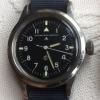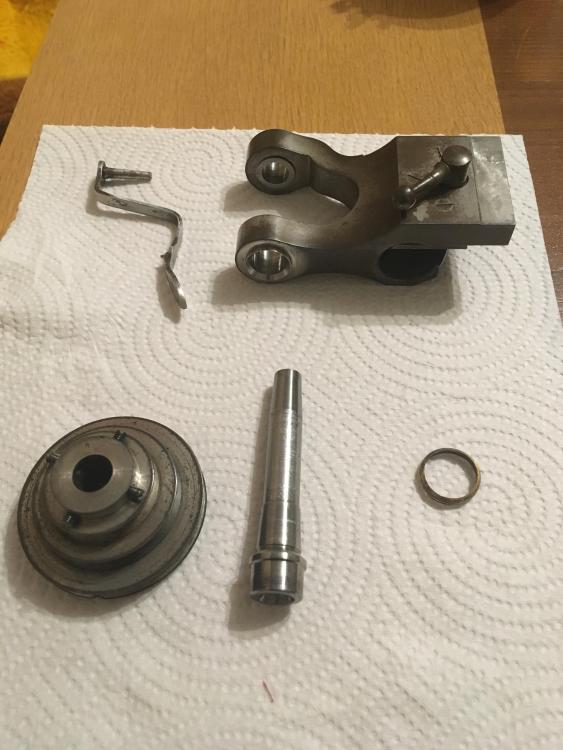Leaderboard
Popular Content
Showing content with the highest reputation on 04/07/22 in Posts
-
ETA 2836-2 Disassembly walkthrough here ETA 2836-2 Assembly walkthrough here When I started out servicing watches (Vostok cal. 2414) I was desperately looking for easy to follow walkthroughs and tutorials. That was several years ago. I did find a walkthrough on WUS, and I did find the YT-videos of former car mechanic Dan, the “Ratfaced Git”, and although his approach was much that of a car mechanic, rather than that of a skilled watch repairer (he hardly knew the names of parts, didn’t care much, and was proud of it), it inspired me endlessly and gave me - at that time a complete mechanical idiot - the courage to try it myself. Without those videos I’m not sure my interest would have taken off. I know Dan struggled with many difficulties in his life including cancer, and it has been close to three years since he published anything on his YT-channel. Anyway, I hope you’re still with us “Ratfaced git” and I say thank you for the inspiration and dedicate this walkthrough to you. In ETA’s technical communication for calibre 2836-2 the assembly is made in seven steps in the following order: 1. Keyless works 2. Train of wheels 3. Mainspring barrel and bridge 4. Balance assembly 5. Self-winding mechanism 6. Dial train (/motion works) and the calendar works part 1 7. Dial train (/motion works) and the calendar works part 2 However, if you follow my assembly procedure, I put it together in a different order as I find it more convenient and wish to test the running of the watch as soon possible, that is, as soon as the train of wheels, barrel, and balance have been replaced. If at that point it’s not running well, I can more easily deal with it before continuing on with the assembly. Also, should problems arise at a later stage I’ll know it’s (very likely) not related to the train, barrel or balance. The downside, of course, is that the balance is exposed to potential damage for a longer period, although it can of course be removed. So, here are the steps of my assembly procedure: 1. Train of wheels 2. Mainspring barrel and bridge 3. Balance assembly 4. Keyless works 5. Dial train (/motion works) and the calendar works part 1 6. Dial train (/motion works) and the calendar works part 2 7. Self-winding mechanism Apart from the click spring and the pallet stones, the oiling suggestions follow ETA’s technical communication. Finally, I make walkthroughs for my personal use and enjoyment. They are not meant to be tutorials (for that I wholeheartedly recommend watchrepairlessons.com), but I like to share them in case there’s someone who would find them useful. So, without further ado…1 point
-
1 point
-
I’d use the new spring. The old one doesn’t look awful, but it is fairly “set”. If you are lucky then the new spring’s ring will be narrower than the barrel. If not, then remove first and use a spring winder. The hooking end that wraps around the arbor is annealed and will conform to the arbor of the winder or the watch barrel without intervention usually.1 point
-
Its about moving pallets inward and outward in the fork slot, so to optimize the impulse deilvered to the impulse jewel. There has been many discusion on the subject with pictures illustrating details, with Swiss lever the need for adjusting pallets is significant, the task involves dealing with the" lock" run to the drop " and " drop" at the right instance, also issue of overbanming is of concern. I'd say at this point you best practice with clean&lube and regulating of a movement, hopefully you will soon be ready to step in the mind field called pallet adjustment. Regards1 point
-
1 point
-
Ticking, ticking, ticking, ticking, ticking .... Thank you, Thank you, Thank you. You are not going to believe it. When I damaged the escape wheels (yes, plural), I obtained replacements which included a pallet fork. I used these new pallet forks. They were the problem. The replacements were for an ETA 2789. Supposed to be identical with the ETA 2789-1. They're not. I put the old pallet fork with the replacement escape wheel. Still ticking in any position. Woohoo! Job tomorrow is the calendar side.1 point
-
Did you buy it new? If so send it back it is out of shape. I can see coils touching so there is no even space. I would say it has been used.1 point
-
I have one of these movements in my collection - I wanted one as it's a "high end" ETA movement. I was surprised at how "flimsy" the movement is compared to other ETA models - the mainplate and bridges seem much thinner, than say as 2836. My movement had signs of someone heavy handed having a go - the mainplate was distorted in the centre. Have you checked that all the bridges/cocks sit correctly and the gear train has sufficient endshake throughout ?1 point
-
Hi along with the wise words from the Guru, attached is the 25 service manual hope its some use. 25 (2).pdf1 point
-
Hi Ross when you get the balance out post some pictures of it top bottom pivots and the spring its self, good man for finding the fault with the train,we are nearly there now. when you put the train wheels and bridga on check the rotation ie ( with the watch minus the fork) put a couple of turns on the spring, the wheels will run down and the ecsape wheel will reverse a little at the end. Once accomplished then fit the fork and check its action must be snappy under power, then the balance goes in. If you wish before the fork goes in fit the balance and give it a puff of air and check the rotation and the contricity and flatness of the spring in the free state.1 point
-
Hi Ross can you post some close ups of the balance and spring we may be able to help. Balance spring diagnosis and adjustment is all part of the watch repair life style.1 point
-
it is 2570A. Model 25 movement from 1970 the A is commonly thought of as time of year made. A = first half and B = second half.1 point
-
Is it also worth removing the balance, putting a couple of winds on the main spring and making sure the power is travelling right the way through the train and there's no friction in the movement? Sometimes we focus too much on one area and not the whole thing. Something like poor end shake could be enough to stall it.1 point
-
1 point
-
Something doesn't look right. If you check some of the videos on YouTube, the 784 has another intermediate bridge and another wheel that engages the pinion of the escape wheel.1 point
-
1 point
-
Hi Its a mass produced USA made clock thin plates, Balance spring is salvageable with care. Cleaned up and a drop of windles clock oil it will run. Check all the pivot holes are not worn re bushing plates as thin as those is not easy due to the shortage of metal. but it should run ok. Take your time .1 point
-
Thanks everyone .... sorted. The jewel was in the wrong way up - another lesson learned1 point
-
Do you mean " the balance spin for 30 seconds" or movements runs for 30 seconds then stops. My take was , when you have only the balance&cock on the mainplate. If the movement runs for only 30 seconds, its what weasol says.1 point
-
1 point
-
1 point
-
Thanks for the intro suomaf, welcome to the WRT forum! I'm also relatively new and I'm in the middle of my first service of an Elgin Grade 313 movement. I also did one of Mark's courses after discovering this site. I'm holding off on doing any more as I think that working through my own experiences (with close watching of free YT videos) would be better for me. I'd be interested in hearing your opinion of the cost/benefit of Mark's courses if you've done any.1 point
-
If the balance wheel tilts when upside down, and the balance wheel pivot is located in the hole jewel, it COULD mean that the hairspring isn’t flat. This MAY potentially affect the amplitude of the watch in the vertical positions. But getting the hairspring flat could also introduce a lot of other problems and is not meant for beginners. I would recommend you look into other potential issues before even thinking about this. I didn’t mean that the pivots were broken causing the lower amplitudes in vertical positions. Since the shoulders of the train wheel pivots rest on the upper and lower jewels in the vertical positions, the increased friction in the vertical positions cause lower amplitude. If the increase in friction is too much, such as due to insufficient end shake, or pivots not polished, the amplitude drop would be larger. But such adjustments would require expensive tools to fix, and special care to diagnose. When you install everything except the pallet fork and balance cock, and try winding the watch, all the train wheels should spin. Does the escape wheel spin change direction of spin at the last moment? This can be a good indication of train wheel freedom, since it means that all the wheels have very little friction. This is known as back spin, but not all movements may show it. Have you tried timing the watch again after 24hr at full wind? Is there any difference? How did you lubricate the pallet fork? I hope you didn’t lubricate the pallet fork pivots.1 point
-
The good thing is your vertical positions are all roughly similar, and the horizontal positions roughly similar. Did you measure before servicing? I would let the watch run for 24hr, then fully wind and then measure again. I have observed lower amplitudes just after servicing, which increase after 24hr of running. May be the lubricants haven’t fully distributed properly because my oiling techniques aren’t optimal yet etc. If this doesn’t help you have to manually check all pivots, free running of wheels, end shakes etc. Lower amplitudes in vertical positions are normal due to higher friction between pivots and jewels, but the amplitude shouldn’t be that different from the horizontal. Vertical positions tend to have more friction because the pivots of the wheels have to rest on both jewels, while the horizontal positions is mainly only one jewel, depending on face up or down. Also, I would demagnetize the movement just to be safe, and lower the beat error to below 0.5ms if possible.1 point
-
One of the amusements I have is with horological documentation is who should we believe? Plus the problem of when the various documents came out? For instance two separate ETA calibers were mentioned above both of them having different quantity of parts treated I suppose we should look at the date to see which one may be correct. Or even if we could Ignore the problem with dates who should we believe? I was in a bickering match with someone on another discussion group all because I pointed out that moebius On their current and several generations back of lubrication charts points out something that conflicts with what everyone else in Swatch group is recommending. It makes you wonder how fast technical documentation migrates from one company to another and exactly like our discussion whether the various companies even are going to listen to each other at all? Then there is all the other bits and pieces of technical information that we may or may not ever see that have occurred over time what about that? For instance what about the balance pivots should they be treated? Seems like that might be a nice thing to do but don't think they're currently recommending it. Except Omega in a document I have the 50s they put the solution on pith wood and you push the pivot of the balance In. What about ETA I wonder what they think about that we didn't see it in either the documents that we had obviously it's a? This is where you need the ETA manufacturing information sheets in addition to their normal technical documentation they have manufacturing information sheets. This is where all the nifty technical documentation is which tells you that every single watch they have as far as I can tell all the balance staff pivots are surface treated. Yet we don't see that in any of the normal service guides. I suspect That I already know which school but what year were you there? What becomes interesting for some schools are it's always referred to as an absolute by those on the outside. Then if the students that went to the school compare notes depending upon usually the teacher It can have some dramatic differences in teaching. I wonder how much bigger your bottles going to have to be if you decide to treat more of the watch? As I explained above I can't give you the whole documents and reveal the source of work comes from so I went through and snipped out almost the entire manual. I skipped over there is a little mentioned here and there but skipped over the section on how to test the solution because we would need the special oil and test plates which are only used one time they don't reuse those typically. Nice when you have really deep pockets and can throw things away. Of course the minor problem with the documentation is it's for service center and you using huge quantities of the fluid because you're servicing lots of watches. The principle still apply because as a point out the cleaning fluids will remove prior surface treatment and they feel it has to be replied. Even if the cleaning machines that we have maybe art as efficient as what they have having a watch that's been clean several times is still go to remove the solution is the principles should still apply other then you need really deep pockets to fall the procedure.1 point
-
Congrat Ross. The two movements differ in complicarions only, thence the thickness and so on. I bet pallets of the replacement fork needed adjustment, the old one worked because it was already adjusted.0 points














